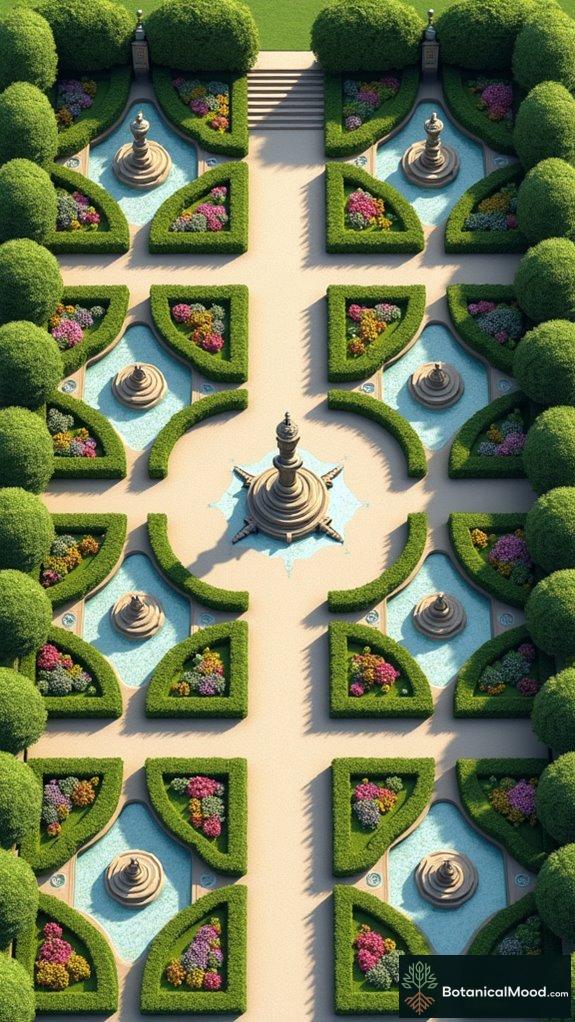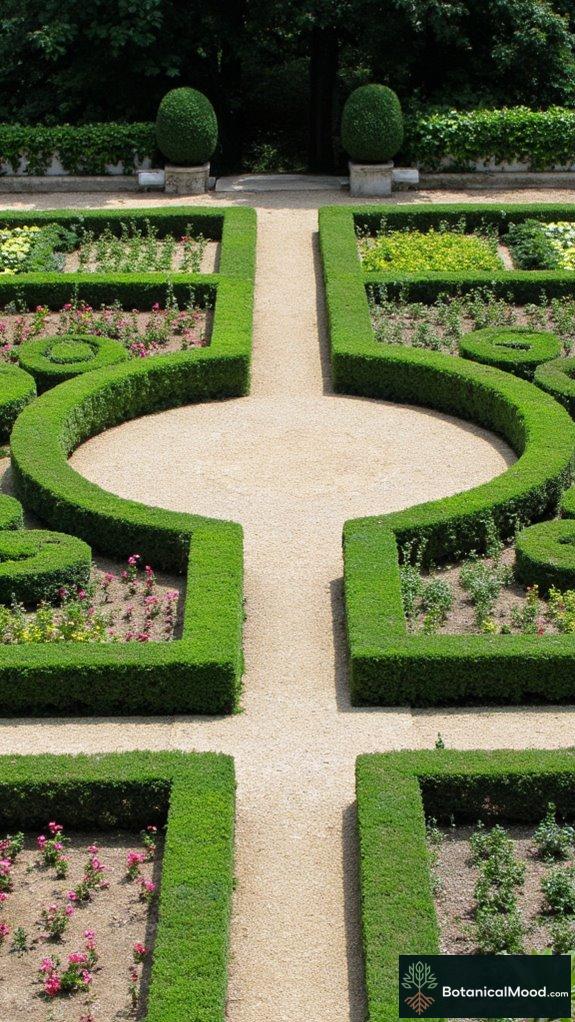Ever tried blending a Zen garden with Greco-Roman flair?
Talk about a design challenge!
I once set out to create a garden that echoed my love for diverse cultures—from peaceful Chinese aesthetics to the grand paths of ancient Rome.
Let’s just say, my first attempt looked like a confused spaghetti monster.
But with a little patience (and a lot of Pinterest scrolling), I managed to sprinkle in tranquility with a dash of elegance, creating a space that speaks to everyone.
Who knew garden design could be such a fun, chaotic, yet ultimately rewarding journey?
The Day My Garden Became a Community Hub
Years ago, I hosted a small garden party, utterly unprepared for what would follow. Neighbors stumbled across my blended oasis—one moment, I was grilling, the next, I was mediating a debate on the best way to grow tomatoes.
This spontaneous gathering sparked a local garden club!
Our shared enthusiasm brought together a beautiful mix of cultures, practicing sustainable gardening methods. Suddenly, my garden wasn’t just my pride and joy; it became a community patchwork where stories, traditions, and fresh ideas bloomed.
Funny how a little dirt, a few plants, and a heap of humor can cultivate connections!
Quick Takeaways
- Garden design can serve as a medium for cultural exchange, integrating diverse traditions and practices that enhance community ties and shared values.
- Traditional gardening techniques preserve cultural heritage, fostering biodiversity through the cultivation of heritage plants and knowledge exchange among communities.
- Elements from various cultures, such as water features or rock arrangements, symbolize local beliefs while promoting natural harmony and tranquility in gardens.
- Urban gardens symbolize multiculturalism by creating edible environments, allowing for communal involvement and celebrating diverse cultural narratives within vibrant ecosystems.
- Successful heritage landscape design incorporates native species and historical narratives, creating living legacies that connect visitors to cultural origins and meanings.
The Influence of Chinese Garden Principles on Global Design
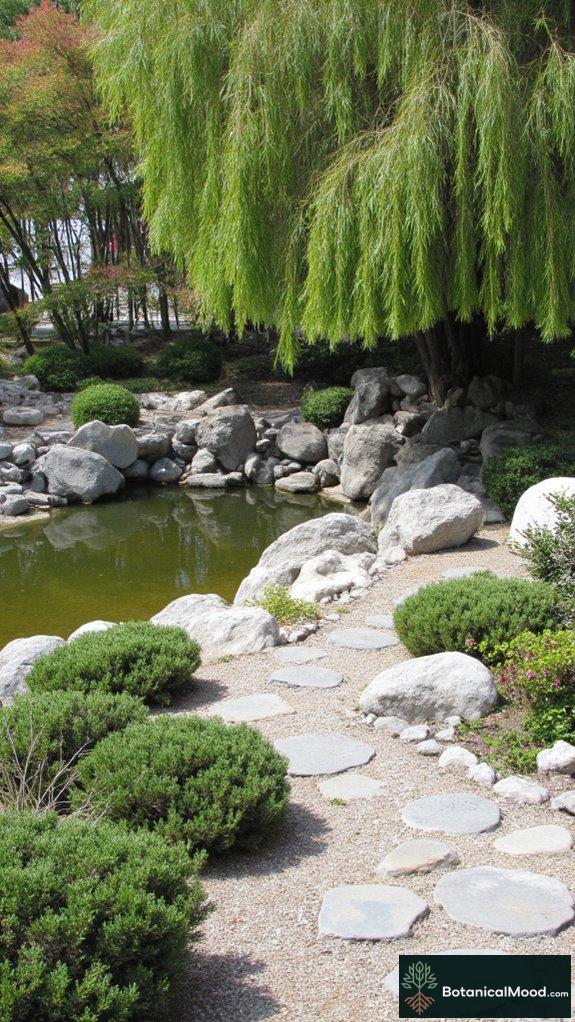
As I explore the detailed world of garden design, I can’t help but marvel at how profoundly Chinese garden principles have influenced environments around the globe.
Their emphasis on Chinese symbolism and natural harmony creates a seamless interplay between seasonal changes and scenery balance.
Incorporating tranquility zones, I’ve found that rock placement and water features foster a contemplative space that invites reflection and serenity.
These design elements not only offer aesthetic pleasure but also underline the philosophical depth of scenery architecture.
Through my journey, I aim to inspire innovative designs that echo the tranquility inherent in Chinese gardens, enriching our connection with nature. Additionally, the use of Zen garden aesthetics can create a simplistic yet profound impact on the overall atmosphere of the landscape.
Greco-Roman Aesthetics in Modern Landscape Architecture

The elegant lines and structured harmony of Greco-Roman aesthetics continue to resonate within modern terrain architecture, creating timeless appeal and sophistication in garden design. I’m particularly inspired by how neoclassical elements, Roman motifs, and Greek patterns infuse contemporary spaces with historical depth. Incorporating pergola designs can evoke the grandeur of ancient temples while providing functional beauty. Additionally, the symmetrical formal garden design principles often seen in classic French gardens complement these ancient aesthetics beautifully.
| Element | Description | Application |
|---|---|---|
| Neoclassical | Symmetrical forms, grandeur | Focal points in gardens |
| Roman Motifs | Arches and stone structures | Walkways and seating |
| Greek Patterns | Geometric designs | Pathway layouts |
Urban Gardens: A Reflection of Multiculturalism and Globalization
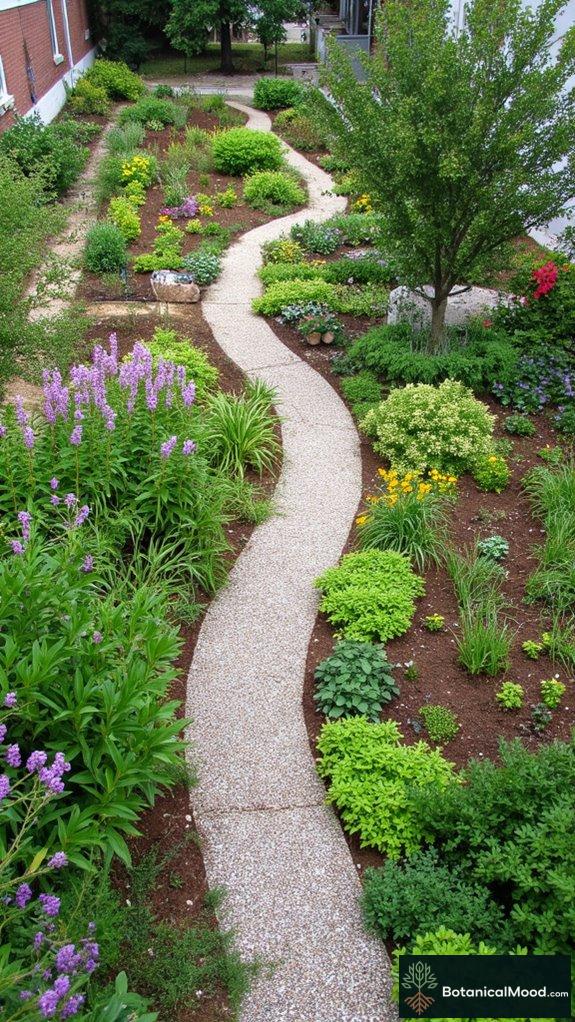
Urban gardens serve as vibrant mosaics, reflecting the multicultural tapestry of our global society. These green spaces, often born from community involvement, cultivate cultural exchange through shared gardening practices, native plants, and diverse design aesthetics.
By integrating elements such as communal plots and edible environments, urban gardens foster a sense of belonging and connectivity among diverse populations.
In this exchange, we witness the beauty of harvested vegetables alongside flowers that tell stories of distant cultures, creating a dynamic ecosystem that celebrates innovation. Additionally, incorporating bee-friendly landscaping not only enhances the beauty of these gardens but also supports crucial pollinators in our ecosystem.
Therefore, each urban garden becomes a living reflection of our collective identity, transcending boundaries while nurturing a sustainable future.
Preservation of Traditional Gardening Techniques in a Modern World

While many modern gardeners embrace innovative techniques and advanced technology, preserving traditional gardening methods offers a profound connection to both our cultural heritage and the environment.
By integrating historical practices into our contemporary spaces, we can foster community involvement and sustainability. Here are three ways to honor these time-honored techniques:
- Workshops: Organize events to share knowledge about ancestral gardening methods.
- Heritage Plants: Cultivate native species that promote biodiversity and reflect local culture.
- Collaborative Gardens: Create communal spaces where diverse groups can exchange traditional wisdom and modern ideas, enhancing our creative environments at Botanical Mood.
Sustainable Gardening Practices: Learning From Indigenous Systems

Understanding sustainable gardening practices requires us to look towards the wisdom embedded within indigenous systems, as they offer invaluable viewpoints into ecological harmony and resilience.
Adopting indigenous practices fosters an ecological balance, promoting biodiversity and enhancing soil health. I’ve learned that integrating traditional knowledge with modern techniques can spark innovation in our gardens.
Here’s a brief overview:
| Indigenous Practice | Ecological Benefit | Modern Application |
|---|---|---|
| Companion Planting | Pest control | Interplanting strategies |
| Multi-cropping | Soil fertility | Diverse cropping systems |
| Water Conservation | Efficient usage | Rainwater harvesting |
| Seasonal Rotation | Pest suppression | Integrated pest management |
| Native Plant Use | Habitat enhancement | Pollinator-friendly design |
Innovations in Garden Design Through Digital Documentation

As garden design evolves, embracing digital documentation has become increasingly essential for creating visually striking and ecologically sound environments. Digital mapping aids in crafting precise terrains, ensuring that every element harmonizes with the surroundings.
Here are three key innovations to contemplate:
- Real-time Data Collection: Integrating sensors and drones captures data for accurate garden documentation, revealing how ephemeral elements can thrive.
- 3D Visualization: Programs allow for immersive design experiences, enabling clients to visualize their future gardens.
- Collaborative Platforms: These facilitate sharing ideas and designs, fostering community-driven projects that enhance creativity.
Hybrid Gardens: Celebrating Cultural Diversity in Urban Spaces

Hybrid gardens, which blend diverse cultural plant selections and design philosophies, showcase the beauty that emerges when different heritages intertwine in urban environments.
These vibrant spaces act as community gardens, allowing local populations to engage in cultural fusion through plant diversity and landscaping strategies.
Imagine stepping into a Korean-inspired terrace adorned with native Mediterranean herbs alongside traditional African marigolds; it’s exhilarating!
Stepping into a vibrant fusion of Korean terraces and Mediterranean herbs brings an exhilarating celebration of cultural diversity.
Utilizing diverse foliage textures and color palettes, hybrid gardens offer innovative solutions that celebrate cultural richness.
As I explore these enchanting designs, I’m reminded how Botanical Mood aims to inspire others to embrace this unique, harmonious approach to urban gardening.
Traditional Land Use Principles

Traditional land use principles serve as the backbone of effective terrain design, integrating the ecological, cultural, and historical elements of a site to form cohesive and harmonious spaces.
- Emphasizing cultural continuity through native vegetation fosters a strong connection to history. This approach underscores the importance of preserving intact natural areas to maintain the ecological integrity of local landscapes.
- Tailoring pathways and spaces based on their intended purpose enhances usability while promoting ecological integration.
- Respecting local character by conserving natural features creates a seamless blend between landscaping and environment.
Heritage Garden Spatial Arrangements
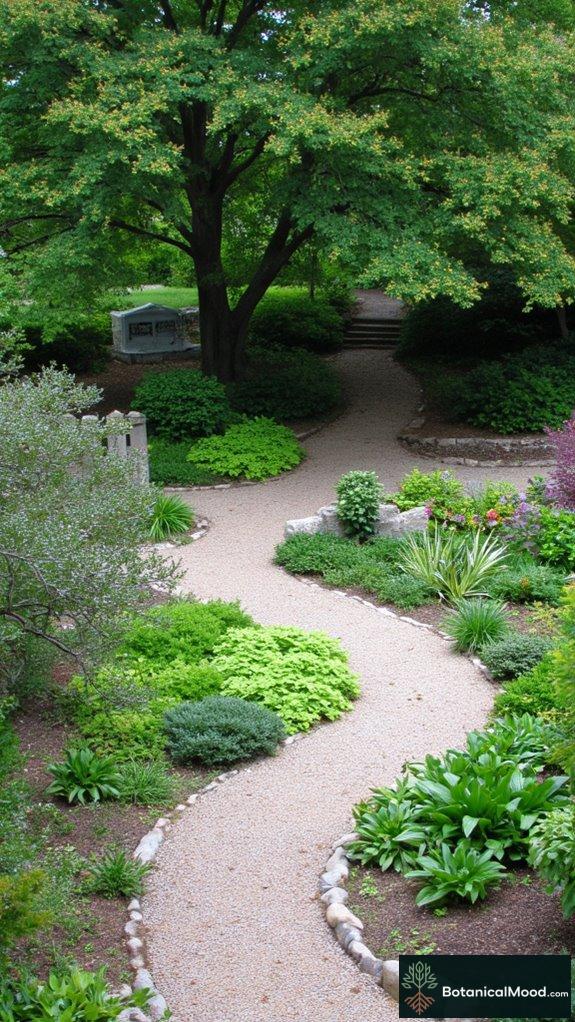
What elements help create a balanced, inviting Heritage Garden?
In my experience, the interplay of cultural significance and spatial narratives is essential.
I focus on arranging flora in a way that reflects the garden’s history—think of towering trees, gentle pathways, and serene seating areas. Each plant has a story, connecting visitors to its origins and meanings, while thoughtfully designed zones invite exploration.
Incorporating native species not only enhances biodiversity but also pays homage to local traditions.
Lighting plays a significant role, softly illuminating these spaces, inviting contemplation and connection.
Culturally-Inspired Design Elements

Culturally-inspired design elements in the garden create a profound narrative, harmonizing beauty with heritage. By infusing spaces with cultural symbolism, I curate spatial narratives that resonate deeply with community identity and collective memory.
- Architectural Features: Temples and pavilions act as essential cultural symbols, showcasing the evolution of societal values throughout history.
- Native Flora: Indigenous plants anchor our environments, reflecting local spiritual beliefs and practices.
- Water Features: Ponds and fountains embody the essence of life and adjacent gatherings.
These elements not only enrich aesthetic appeal but also serve as conduits of history, fostering connections between people, place, and purpose.
Heritage Landscape Design Approaches
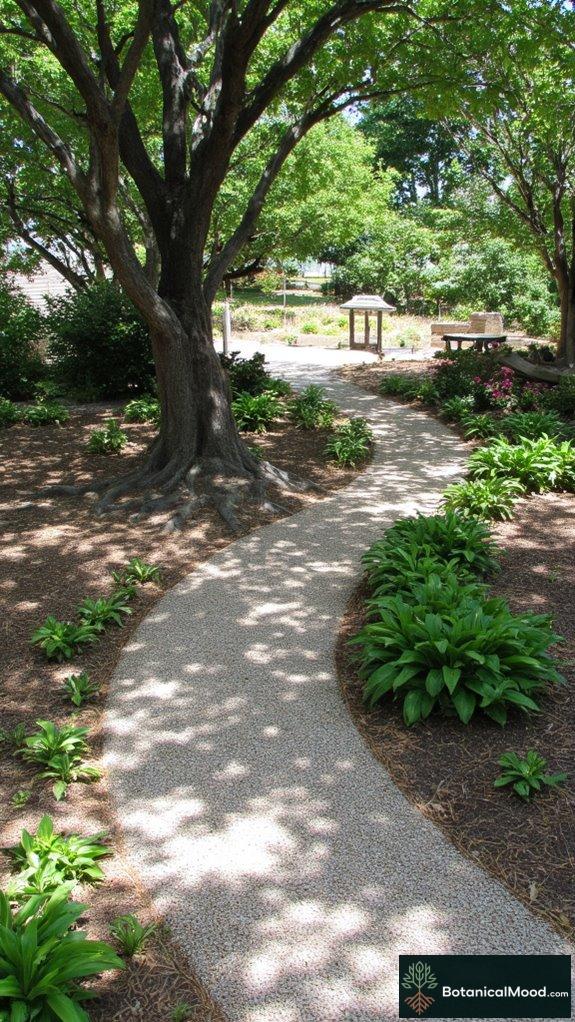
Heritage terrain design approaches prioritize the thoughtful integration of historical narratives and environmental sustainability, creating spaces that honor the past while nurturing the present.
I find great beauty in heritage plantings that reflect local ecosystems, combining ecological preservation with authenticity. By selecting native or historically appropriate species, we create living legacies that respect traditional environments. Researching historical accuracy of plants ensures that we choose vegetation that not only thrives but also tells the story of our cultural heritage.
Heritage plantings embody the essence of local ecosystems, blending ecological integrity with historical authenticity for future generations to cherish.
Companion planting near heritage trees safeguards their roots and rejuvenates soil quality, while employing sustainable methods, such as organic gardening and water conservation, enhances overall resilience.
These practices enrich our gardens, inviting future generations to appreciate the complex connection between nature, history, and thoughtful design.
How To Design Cultural Heritage Landscape Patterns

How can we create scenery patterns that not only reflect our cultural heritage but also celebrate the natural beauty surrounding them?
To design effective cultural heritage environment patterns, let’s focus on three key elements:
- Spatial Organization: Utilize natural features for defining boundaries and circulation routes, aligning them with historical land use. This creates a connection to vernacular landscapes that have evolved naturally through community practices.
- Environment Authenticity: Select historically significant plants and materials that echo the cultural identity and promote ecological sustainability.
- Historical Preservation: Integrate stratigraphic layering to reveal the evolution of cultural practices, infusing our designs with a profound narrative that respects traditions while fostering innovation.
This approach marries beauty with meaningful storytelling.
Cultural Heritage Landscape Curator

The garden is owned by Thompson, a passionate terrain designer from the Pacific Northwest. Inspired by her childhood experiences exploring botanical gardens, she envisioned a vibrant space that honored local flora and heritage.
To bring her vision to life, Thompson underwent a meticulous design process, collaborating with cultural heritage terrain curators and horticulturists to analyze site conditions and historical narratives, embracing sustainable practices. This approach reflects the curators’ expanded skill set in connecting historical elements with contemporary environmental issues.
By incorporating elements from renowned terrain designs, she crafted a plan that seamlessly melded aesthetics with ecological integrity.
Thompson utilized tools such as the GardenFork shovel and Fiskars pruners, and incorporated stylish accessories from brands like Martha Stewart Living.
She worked with local horticulturist Jamie Smith to select native plants and materials that would thrive in the terrain while preserving its cultural essence.
Renowned Garden Design Pioneers

Garden design has long captivated those who appreciate nature’s artistry, and understanding the pioneers behind this craft reveals the depth of creativity and innovation that shapes our environments today.
Historical influences like Capability Brown‘s pastoral vistas and Gertrude Jekyll‘s textured, colorful gardens guide the design evolution we admire. Their architectural collaborations, alongside female pioneers like Ellen Biddle Shipman, redefine cultural legacies in garden aesthetics.
Each design, from the soft contours of formal settings to the robust functionality of public parks, reflects a pursuit of beauty, blending practicality with artistry.
I created Botanical Mood to celebrate these transformative designs that inspire and elevate our shared environments.
Garden Design FAQ
How Can I Incorporate Local Plants Into My Garden Design?
To incorporate local plants into my garden design, I’ve focused on enhancing native biodiversity and embracing sustainable aesthetics.
I carefully select plants that thrive in my climate, ensuring they support local wildlife and contribute to the ecosystem.
For instance, I integrate native wildflowers and shrubs, creating vibrant color combinations while minimizing water usage.
What Are Some Common Mistakes in Multicultural Garden Designs?
In multicultural garden designs, I’ve noticed common mistakes can lead to issues like cultural appropriation and lack of design cohesion.
For instance, overly mixing plants without understanding their cultural significance can dilute the narrative.
It’s essential to explore plants’ origins and use them thoughtfully, creating harmony with colors, textures, and structures.
I prioritize innovative combinations that celebrate diversity while respecting each culture, developing a garden that feels authentic yet cohesive in its messaging.
How Does Climate Impact Garden Design Choices Globally?
Climate’s like the maestro of garden design, conducting the symphony of choices we make.
Different climate zones demand adaptability in plant selection, while seasonal shifts inform the rhythm of blooms and foliage changes.
Soil types and water availability dictate what thrives, and temperature ranges influence plant health.
The biodiversity impact fosters unique ecosystems that enrich our designs, emphasizing environmental sustainability.
It’s this harmony of elements that inspires my passion for gardening innovation.
What Resources Exist for Learning Traditional Gardening Techniques?
To learn traditional gardening techniques, I find online courses, culturally rich gardening books, and local cultural workshops incredibly valuable.
These resources offer hands-on training that can deepen my understanding of soil health, plant selection, and ecological practices unique to different regions.
Exploring the complex balance of colors in garden design, I appreciate how these techniques connect me to the beauty of nature, enriching both my personal and professional gardening experience.
How Can I Engage My Community in a Garden Project?
To engage my community in a garden project, I organize community workshops and volunteer events.
First, I gather ideas on what plants and designs resonate with everyone, ensuring their voices matter.
Then, I incorporate innovative techniques, like permaculture principles, into our design.
Creating a vibrant atmosphere encourages participation, and we beautify our shared space together.
It’s rewarding to witness our garden thrive, fostering connections through nature and shared experience.
Share Your Own Garden
As I explore global garden wisdom, I find beauty in blending diverse cultures and traditions. Every garden tells its own story, whether it’s the tranquility of a Chinese design or the lively spirit of urban greens. I’m reminded that nurturing plants also nurtures our shared heritage and sustainability.
I’d love to hear about your experiences with gardening—what traditions or cultures inspire you?
Feel free to share photos of your garden! I’m curious about how you designed it and the elements that hold special meaning for you.
References
- https://www.europeanproceedings.com/article/10.15405/epsbs.2022.03.27
- https://lifestyle.sustainability-directory.com/question/how-does-cultural-background-influence-garden-perception/
- https://verdenook.com/articles/global-gardening-cultural-harmony
- https://pmc.ncbi.nlm.nih.gov/articles/PMC12185156/
- https://www.newportbeachmagazine.com/global-garden-trends-international-inspirations-for-your-outdoor-space/
- https://codelibrary.amlegal.com/codes/sangabriel/latest/sangabriel_ca/0-0-0-29133
- https://content.ces.ncsu.edu/extension-gardener-handbook/19-landscape-design
- https://www.terrain.org/articles/7/arendt.htm
- https://pmc.ncbi.nlm.nih.gov/articles/PMC3666687/
- https://www3.uwsp.edu/cnr-ap/UWEXLakes/Documents/ecology/shoreland/landscaping/g1923_planning_designing_home_landscape.pdf

